Kai Wei
SIPDO: Closed-Loop Prompt Optimization via Synthetic Data Feedback
May 26, 2025Abstract:Prompt quality plays a critical role in the performance of large language models (LLMs), motivating a growing body of work on prompt optimization. Most existing methods optimize prompts over a fixed dataset, assuming static input distributions and offering limited support for iterative improvement. We introduce SIPDO (Self-Improving Prompts through Data-Augmented Optimization), a closed-loop framework for prompt learning that integrates synthetic data generation into the optimization process. SIPDO couples a synthetic data generator with a prompt optimizer, where the generator produces new examples that reveal current prompt weaknesses and the optimizer incrementally refines the prompt in response. This feedback-driven loop enables systematic improvement of prompt performance without assuming access to external supervision or new tasks. Experiments across question answering and reasoning benchmarks show that SIPDO outperforms standard prompt tuning methods, highlighting the value of integrating data synthesis into prompt learning workflows.
Crowdsourcing-Based Knowledge Graph Construction for Drug Side Effects Using Large Language Models with an Application on Semaglutide
Apr 08, 2025Abstract:Social media is a rich source of real-world data that captures valuable patient experience information for pharmacovigilance. However, mining data from unstructured and noisy social media content remains a challenging task. We present a systematic framework that leverages large language models (LLMs) to extract medication side effects from social media and organize them into a knowledge graph (KG). We apply this framework to semaglutide for weight loss using data from Reddit. Using the constructed knowledge graph, we perform comprehensive analyses to investigate reported side effects across different semaglutide brands over time. These findings are further validated through comparison with adverse events reported in the FAERS database, providing important patient-centered insights into semaglutide's side effects that complement its safety profile and current knowledge base of semaglutide for both healthcare professionals and patients. Our work demonstrates the feasibility of using LLMs to transform social media data into structured KGs for pharmacovigilance.
Towards Single-Lens Controllable Depth-of-Field Imaging via All-in-Focus Aberration Correction and Monocular Depth Estimation
Sep 15, 2024



Abstract:Controllable Depth-of-Field (DoF) imaging commonly produces amazing visual effects based on heavy and expensive high-end lenses. However, confronted with the increasing demand for mobile scenarios, it is desirable to achieve a lightweight solution with Minimalist Optical Systems (MOS). This work centers around two major limitations of MOS, i.e., the severe optical aberrations and uncontrollable DoF, for achieving single-lens controllable DoF imaging via computational methods. A Depth-aware Controllable DoF Imaging (DCDI) framework is proposed equipped with All-in-Focus (AiF) aberration correction and monocular depth estimation, where the recovered image and corresponding depth map are utilized to produce imaging results under diverse DoFs of any high-end lens via patch-wise convolution. To address the depth-varying optical degradation, we introduce a Depth-aware Degradation-adaptive Training (DA2T) scheme. At the dataset level, a Depth-aware Aberration MOS (DAMOS) dataset is established based on the simulation of Point Spread Functions (PSFs) under different object distances. Additionally, we design two plug-and-play depth-aware mechanisms to embed depth information into the aberration image recovery for better tackling depth-aware degradation. Furthermore, we propose a storage-efficient Omni-Lens-Field model to represent the 4D PSF library of various lenses. With the predicted depth map, recovered image, and depth-aware PSF map inferred by Omni-Lens-Field, single-lens controllable DoF imaging is achieved. Comprehensive experimental results demonstrate that the proposed framework enhances the recovery performance, and attains impressive single-lens controllable DoF imaging results, providing a seminal baseline for this field. The source code and the established dataset will be publicly available at https://github.com/XiaolongQian/DCDI.
End-to-end spoken language understanding using joint CTC loss and self-supervised, pretrained acoustic encoders
May 04, 2023



Abstract:It is challenging to extract semantic meanings directly from audio signals in spoken language understanding (SLU), due to the lack of textual information. Popular end-to-end (E2E) SLU models utilize sequence-to-sequence automatic speech recognition (ASR) models to extract textual embeddings as input to infer semantics, which, however, require computationally expensive auto-regressive decoding. In this work, we leverage self-supervised acoustic encoders fine-tuned with Connectionist Temporal Classification (CTC) to extract textual embeddings and use joint CTC and SLU losses for utterance-level SLU tasks. Experiments show that our model achieves 4% absolute improvement over the the state-of-the-art (SOTA) dialogue act classification model on the DSTC2 dataset and 1.3% absolute improvement over the SOTA SLU model on the SLURP dataset.
Dialog act guided contextual adapter for personalized speech recognition
Mar 31, 2023
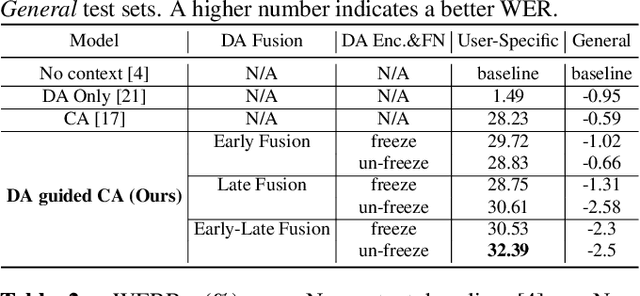
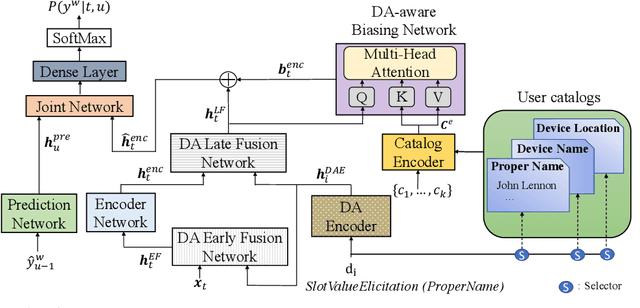
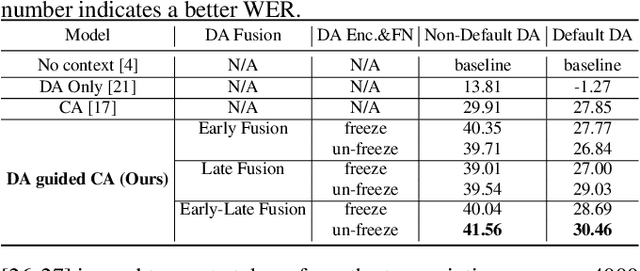
Abstract:Personalization in multi-turn dialogs has been a long standing challenge for end-to-end automatic speech recognition (E2E ASR) models. Recent work on contextual adapters has tackled rare word recognition using user catalogs. This adaptation, however, does not incorporate an important cue, the dialog act, which is available in a multi-turn dialog scenario. In this work, we propose a dialog act guided contextual adapter network. Specifically, it leverages dialog acts to select the most relevant user catalogs and creates queries based on both -- the audio as well as the semantic relationship between the carrier phrase and user catalogs to better guide the contextual biasing. On industrial voice assistant datasets, our model outperforms both the baselines - dialog act encoder-only model, and the contextual adaptation, leading to the most improvement over the no-context model: 58% average relative word error rate reduction (WERR) in the multi-turn dialog scenario, in comparison to the prior-art contextual adapter, which has achieved 39% WERR over the no-context model.
A neural prosody encoder for end-ro-end dialogue act classification
May 11, 2022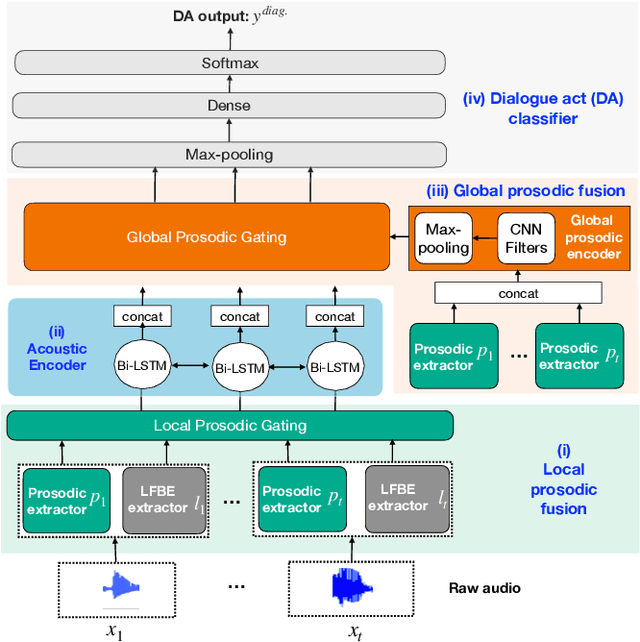

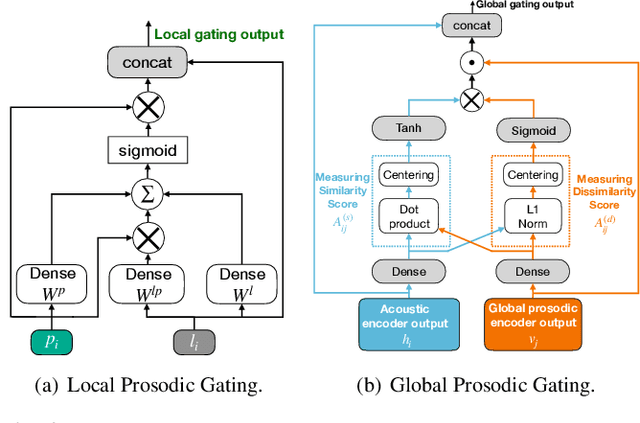

Abstract:Dialogue act classification (DAC) is a critical task for spoken language understanding in dialogue systems. Prosodic features such as energy and pitch have been shown to be useful for DAC. Despite their importance, little research has explored neural approaches to integrate prosodic features into end-to-end (E2E) DAC models which infer dialogue acts directly from audio signals. In this work, we propose an E2E neural architecture that takes into account the need for characterizing prosodic phenomena co-occurring at different levels inside an utterance. A novel part of this architecture is a learnable gating mechanism that assesses the importance of prosodic features and selectively retains core information necessary for E2E DAC. Our proposed model improves DAC accuracy by 1.07% absolute across three publicly available benchmark datasets.
Distributed Neural Precoding for Hybrid mmWave MIMO Communications with Limited Feedback
Apr 18, 2022



Abstract:Hybrid precoding is a cost-efficient technique for millimeter wave (mmWave) massive multiple-input multiple-output (MIMO) communications. This paper proposes a deep learning approach by using a distributed neural network for hybrid analog-and-digital precoding design with limited feedback. The proposed distributed neural precoding network, called DNet, is committed to achieving two objectives. First, the DNet realizes channel state information (CSI) compression with a distributed architecture of neural networks, which enables practical deployment on multiple users. Specifically, this neural network is composed of multiple independent sub-networks with the same structure and parameters, which reduces both the number of training parameters and network complexity. Secondly, DNet learns the calculation of hybrid precoding from reconstructed CSI from limited feedback. Different from existing black-box neural network design, the DNet is specifically designed according to the data form of the matrix calculation of hybrid precoding. Simulation results show that the proposed DNet significantly improves the performance up to nearly 50% compared to traditional limited feedback precoding methods under the tests with various CSI compression ratios.
Multi-task RNN-T with Semantic Decoder for Streamable Spoken Language Understanding
Apr 01, 2022
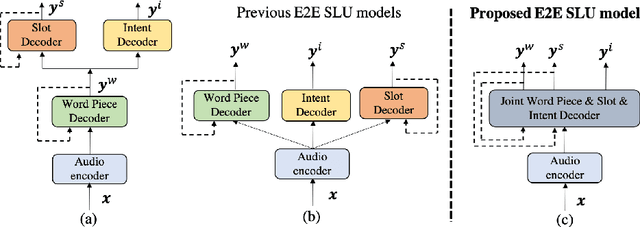

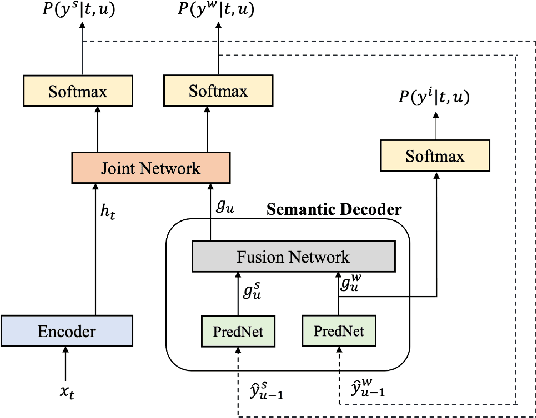
Abstract:End-to-end Spoken Language Understanding (E2E SLU) has attracted increasing interest due to its advantages of joint optimization and low latency when compared to traditionally cascaded pipelines. Existing E2E SLU models usually follow a two-stage configuration where an Automatic Speech Recognition (ASR) network first predicts a transcript which is then passed to a Natural Language Understanding (NLU) module through an interface to infer semantic labels, such as intent and slot tags. This design, however, does not consider the NLU posterior while making transcript predictions, nor correct the NLU prediction error immediately by considering the previously predicted word-pieces. In addition, the NLU model in the two-stage system is not streamable, as it must wait for the audio segments to complete processing, which ultimately impacts the latency of the SLU system. In this work, we propose a streamable multi-task semantic transducer model to address these considerations. Our proposed architecture predicts ASR and NLU labels auto-regressively and uses a semantic decoder to ingest both previously predicted word-pieces and slot tags while aggregating them through a fusion network. Using an industry scale SLU and a public FSC dataset, we show the proposed model outperforms the two-stage E2E SLU model for both ASR and NLU metrics.
Attentive Contextual Carryover for Multi-Turn End-to-End Spoken Language Understanding
Dec 13, 2021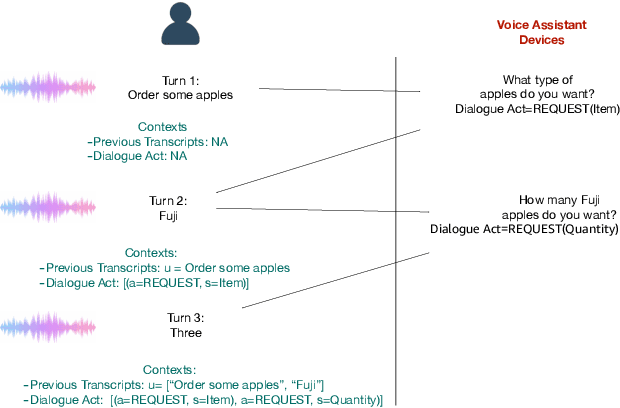
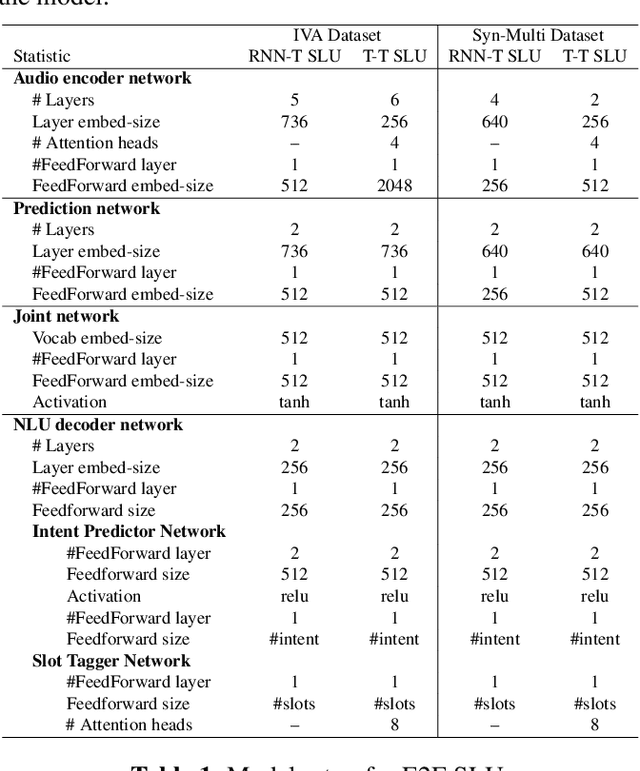
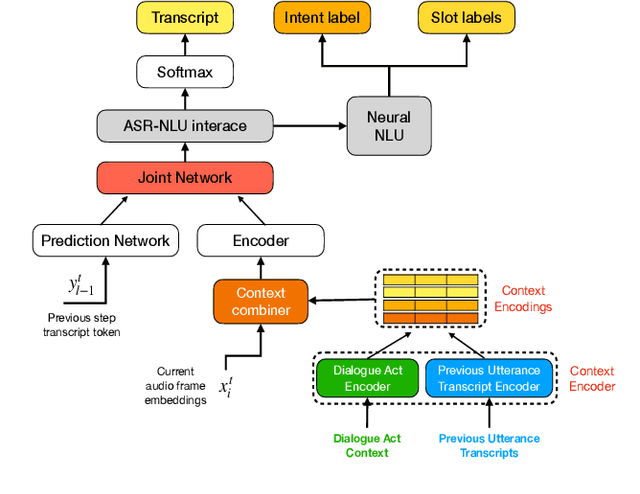
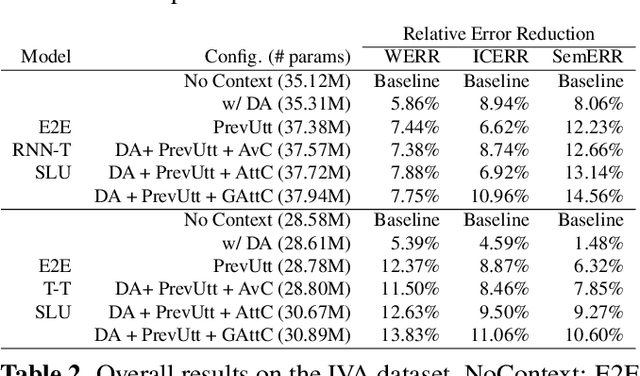
Abstract:Recent years have seen significant advances in end-to-end (E2E) spoken language understanding (SLU) systems, which directly predict intents and slots from spoken audio. While dialogue history has been exploited to improve conventional text-based natural language understanding systems, current E2E SLU approaches have not yet incorporated such critical contextual signals in multi-turn and task-oriented dialogues. In this work, we propose a contextual E2E SLU model architecture that uses a multi-head attention mechanism over encoded previous utterances and dialogue acts (actions taken by the voice assistant) of a multi-turn dialogue. We detail alternative methods to integrate these contexts into the state-ofthe-art recurrent and transformer-based models. When applied to a large de-identified dataset of utterances collected by a voice assistant, our method reduces average word and semantic error rates by 10.8% and 12.6%, respectively. We also present results on a publicly available dataset and show that our method significantly improves performance over a noncontextual baseline
Encoding Syntactic Knowledge in Transformer Encoder for Intent Detection and Slot Filling
Dec 21, 2020



Abstract:We propose a novel Transformer encoder-based architecture with syntactical knowledge encoded for intent detection and slot filling. Specifically, we encode syntactic knowledge into the Transformer encoder by jointly training it to predict syntactic parse ancestors and part-of-speech of each token via multi-task learning. Our model is based on self-attention and feed-forward layers and does not require external syntactic information to be available at inference time. Experiments show that on two benchmark datasets, our models with only two Transformer encoder layers achieve state-of-the-art results. Compared to the previously best performed model without pre-training, our models achieve absolute F1 score and accuracy improvement of 1.59% and 0.85% for slot filling and intent detection on the SNIPS dataset, respectively. Our models also achieve absolute F1 score and accuracy improvement of 0.1% and 0.34% for slot filling and intent detection on the ATIS dataset, respectively, over the previously best performed model. Furthermore, the visualization of the self-attention weights illustrates the benefits of incorporating syntactic information during training.
 Add to Chrome
Add to Chrome Add to Firefox
Add to Firefox Add to Edge
Add to Edge